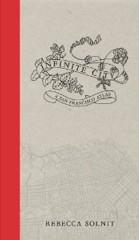Review: Infinite City
Infinite City: A San Francisco Atlas
by Rebecca Solnit
University of California Press, 2010. Hardcover and paperback, 164 pp.
ISBN 978-0-520-26249-2 (hardcover); 978-0-520-26250-8 (paperback)
 Not every city has a soul: some are decidedly soulless. But while I’ve never been to San Francisco, it seems to me that it, at least, is one that does. Cities like that can be magical places: they don’t just have histories, but mythologies, too. “This atlas is a valentine of sorts to a complex place,” Rebecca Solnit writes in the acknowledgements to Infinite City: A San Francisco Atlas, itself a complex and many-layered book. The 22 maps and accompanying essays, by divers cartographers, artists and writers, depict a San Francisco with a layered history, and in many ways is a record of a city that has been lost to history. The San Francisco in these maps is a palimpsest, the city repeatedly overwritten, maps and histories overlaying one another.
Not every city has a soul: some are decidedly soulless. But while I’ve never been to San Francisco, it seems to me that it, at least, is one that does. Cities like that can be magical places: they don’t just have histories, but mythologies, too. “This atlas is a valentine of sorts to a complex place,” Rebecca Solnit writes in the acknowledgements to Infinite City: A San Francisco Atlas, itself a complex and many-layered book. The 22 maps and accompanying essays, by divers cartographers, artists and writers, depict a San Francisco with a layered history, and in many ways is a record of a city that has been lost to history. The San Francisco in these maps is a palimpsest, the city repeatedly overwritten, maps and histories overlaying one another.
A key strategy employed by the artists and cartographers in Infinite City is to display two things on the same map — sometimes complementary, sometimes contrasting: drag queens and butterflies, murders and cypresses (“death and beauty”), zen centers and salmon rivers. The accompanying essays make the case for these combinations.
Though invariably artful and beautiful, the cartography is frequently not much to write home about. Some of the maps are of the labels-and-dots variety, and could, at least from a cartographical perspective, be rendered equally well in Google Maps, though the result wouldn’t nearly be as visually appealing.
The maps that stood out in my mind were those that departed from the standard template: “Third Street Phantom Coast” (#10) compares the pre-1849 and 2010 shorelines (among other things); “Graveyard Shift” (#11) shows the now-lost industrial and port sector of the city; “Once and Future Waters” (#22) takes the 1850 landmass and compares it to where the sea levels will be in 2100 if the sea level rises 1.5 metres. Some venture toward art: a phrenological map (#19) and a treasure map (#21). “The Mission” (#13) superimposes the U.S.-Mexico border on a map of the Mission District that includes gang territories.
But the strength in this book is in the essays, which is a strange thing to say about an atlas, particularly in a review on a map blog. Above all else, Infinite City is about telling San Francisco’s stories — using both narratives and maps to do so. The maps aren’t at all scientific or demographic; there are no cartograms or choropleths, and no GIS appears to have been harmed in their making. They tell tales — idiosyncratic tales, comprising an unconventional book.
I received a review copy of this book.
Previously: Infinite City: A “Fanciful” Atlas of San Francisco; LA Times Reviews Infinite City; Radio Interview About Infinite City.
- Buy Infinite City (hardcover) at Amazon.com (Canada, UK)
- Buy Infinite City (paperback) at Amazon.com (Canada, UK)

Comments
blog comments powered by Disqus